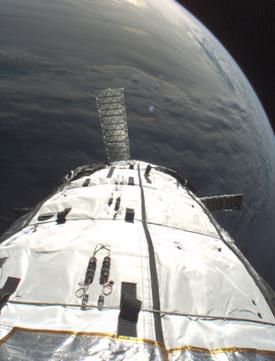 Image from one of the seven exterior cameras on Genesis I | |
| Mission type | Experimental uncrewed space station |
|---|---|
| Operator | Bigelow Aerospace |
| COSPAR ID | 2006-029A |
| SATCAT no. | 29252 |
| Mission duration | 6 months (planned) 2.5 years (achieved) 18 years, 3 months and 22 days (in orbit) |
| Spacecraft properties | |
| Spacecraft | Space station |
| Spacecraft type | Genesis |
| Manufacturer | Bigelow Aerospace |
| Launch mass | 1,360 kg (3,000 lb) [1] |
| Dimensions | 4.40 m (14.4 ft) of long 2.54 m (8 ft 4 in) of diameter 11.50 m3 (406 cu ft) of volume 51.70 kPa (7.498 psi) of pressure [2] |
| Start of mission | |
| Launch date | 12 July 2006, 14:53:36 UTC[3] |
| Rocket | Dnepr |
| Launch site | Dombarovsky, Russia |
| Contractor | Yuzhmash |
| End of mission | |
| Disposal | Reentry (expected) [4] |
| Deactivated | Retired, on orbit [5] |
| Orbital parameters | |
| Reference system | Geocentric orbit[6] |
| Regime | Low Earth orbit |
| Perigee altitude | 470 km (290 mi) |
| Apogee altitude | 480 km (300 mi) |
| Inclination | 64.52° |
| Period | 94.84 minutes |
Genesis program | |
Genesis I is an experimental space habitat designed and built by the private American firm Bigelow Aerospace and launched in 2006. It was the first module to be sent into orbit by the company, and tested various systems, materials and techniques related to determining the viability of long-term inflatable space structures through 2008. Such structures, including this module and others built by Bigelow Aerospace, were similar to the 1990s NASA expandable TransHab design, which aimed to provide increased interior volume at a reduced launch diameter and potentially reduced mass compared to traditional rigid structures.
The on-board systems transmitted data for 2.5 years. The spacecraft remains in orbit, allowing researchers to continue to monitor the long-term viability of its expandable space structure.
- ^ Cite error: The named reference
msnbc397was invoked but never defined (see the help page). - ^ Cite error: The named reference
BAaboutG1was invoked but never defined (see the help page). - ^ "Jonathan's Space Report Launch Log". Planet4589.org. Retrieved 25 December 2020.
- ^ Cite error: The named reference
space060721was invoked but never defined (see the help page). - ^ @BigelowSpace (9 January 2016). "@ras391 We hoped to receive 6 months of uncorrupted data from Genesis I & II. We were in contact for over 2.5 years!" (Tweet). Retrieved 21 February 2016 – via Twitter.
- ^ Peat, Chris (24 December 2020). "Genesis 1 - Orbit". Heavens-Above. Retrieved 25 December 2020.